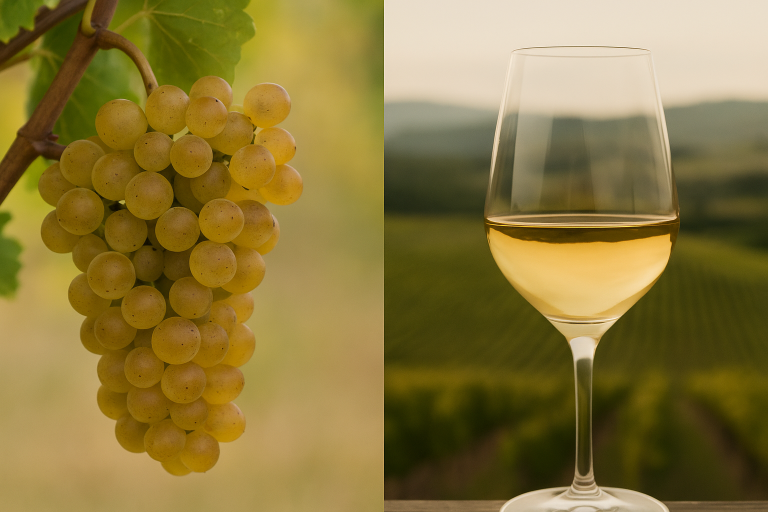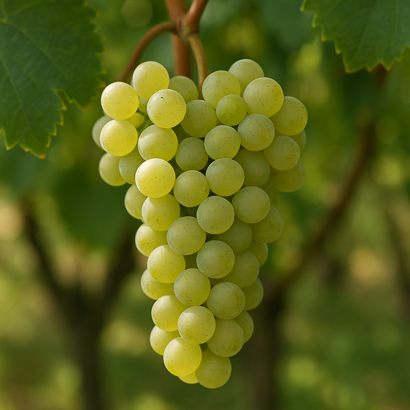When wine lovers discuss the great white varieties of the world, Pinot Blanc is often quietly waiting in the wings. It may not command the same spotlight as Chardonnay or Sauvignon Blanc, but Pinot Blanc holds a special place for those who appreciate subtlety, refinement, and versatility. Crisp yet round, delicate yet complex, Pinot Blanc is a wine that thrives both as an everyday companion and as an elegant pairing for fine cuisine.
Description
Pinot Blanc is a white grape variety belonging to the Pinot family. It is, in fact, a natural mutation of Pinot Noir, which explains its elegant structure and nuanced flavors. Pinot Blanc wines are typically light- to medium-bodied with a soft, creamy texture and refreshing acidity. Aromas often include apple, pear, white peach, citrus blossom, and subtle almond notes.
Unlike many aromatic whites, Pinot Blanc is more about finesse than bold expression. Its flavor profile tends to be clean and balanced, often showing minerality and gentle fruit rather than overt perfume. This makes it an ideal canvas for different winemaking styles, including still, sparkling, and even barrel-aged versions.
History
The history of Pinot Blanc is deeply tied to Burgundy, France, where it emerged centuries ago as part of the complex Pinot family. Its close relationship to Pinot Noir and Pinot Gris (another mutation) has often led to some confusion, and in fact, Pinot Blanc was long mistaken for Chardonnay in some regions.
By the 19th century, Pinot Blanc had spread beyond France, becoming a favored grape in parts of Germany, Italy, and Austria. Its adaptability to cooler climates allowed it to thrive in diverse terroirs. Today, it remains a respected, if somewhat underrated, varietal appreciated by winemakers who value its versatility and elegance.
Regions Produced
Pinot Blanc is grown in several prominent wine regions around the world:
- France: Most notably in Alsace, where it produces delicate, refreshing wines and is sometimes used as a base for sparkling Crémant d’Alsace.
- Germany: Known as Weissburgunder, it produces crisp, mineral-driven wines with a slightly richer texture in warmer sites.
- Italy: Particularly in Alto Adige and Friuli, Pinot Blanc (called Pinot Bianco) shines in clean, elegant expressions often with citrus and floral notes.
- Austria: Widely planted and valued for both still and sparkling wines.
- United States and Canada: Grown in Oregon, California, and British Columbia, where it’s often crafted in a modern, fruit-forward style.
Tasting Notes
Pinot Blanc wines are celebrated for their fresh, approachable character and food-friendly nature.
- Color: Pale straw to light gold.
- Aromas: Green apple, pear, white peach, citrus blossom, almond, and light floral hints.
- Palate: Medium body with crisp acidity, a silky or creamy texture, and flavors of orchard fruits, citrus, and delicate minerality.
- Finish: Clean, refreshing, and slightly nutty, with a lingering sense of freshness.
Winemakers can craft Pinot Blanc in various styles. Unoaked versions highlight its bright fruit and freshness, while barrel-aged expressions develop richer, rounder textures and complex nutty tones. It also serves as an excellent base for sparkling wines, offering finesse and balance.
Conclusion
Pinot Blanc is a grape that proves subtlety can be just as enchanting as boldness. Its understated elegance, versatility, and adaptability to both terroir and winemaking styles make it a treasure for those who seek wines of quiet sophistication.
From the rolling vineyards of Alsace and Alto Adige to the cool climates of Oregon and Germany, Pinot Blanc continues to charm with its refined personality and food-friendly appeal. Whether enjoyed as a crisp aperitif or paired with seafood, poultry, or soft cheeses, Pinot Blanc is a graceful companion that deserves far more time in the spotlight.







